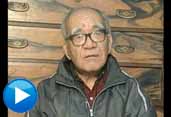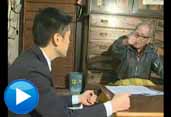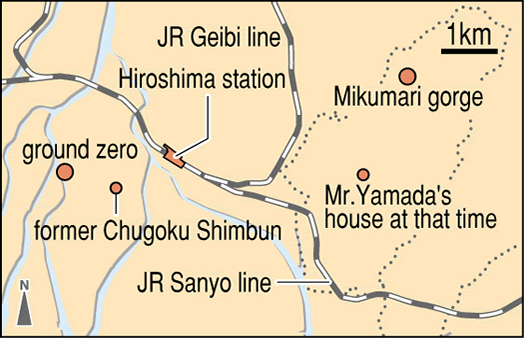The mushroom cloud photographed by Seiso Yamada
Jan. 3, 2008
photographed by Seiso Yamada
Right after the atomic bombing over Hiroshima, a huge mushroom cloud emerged. Though there were a great many eyewitnesses to this cloud, the number of photographs of the cloud is very small. Among them, Seiso Yamada's photograph is thought to be the first one taken after the bombing. The historic image clearly shows the cloud rising into the sky. The Chugoku Shimbun interviewed Mr. Yamada, 79, in mid-December 2007 and sought his experience behind the photograph.
On the morning of August 6, 1945, Mr. Yamada was invited by a friend to go hiking. At the time he was 17 years old, working for the Chugoku Shimbun during the day and attending night school in the evening. It was a fine day and Mr. Yamada took off from work to explore Mikumari Gorge not far from his home. This gorge is located about 6.5 kilometers east of the hypocenter and B-29s were sighted in the sky above that area.
After the bomb exploded, Mr. Yamada quickly took a photograph of the mushroom cloud with the camera he always carried with him. He then turned to head downtown, to check on the Chugoku Shimbun office, about 900 meters from the hypocenter, though the people around him tried to dissuade him from doing so. When Mr. Yamada came upon the devastation, with the survivors in a state of such misery, he gasped in horror.
Seiso Yamada was born on August 2, 1928. He worked for the Chugoku Shimbun in the Sports Division. He covered the Hiroshima Carp, the professional baseball team based in Hiroshima, for many years while also serving as a columnist.
Below is the English translation of Mr. Yamada’s interview.
When I looked up, I saw B-29s. They turned sharply and then dropped some parachutes.
Soon after, though it wasn’t raining, rainbows appeared in the sky. Like ripples from a stone thrown into a pond, the rainbows came in waves.
It was so strange and then suddenly there was an incredible flash. Like magnesium flashing in front of my face. I then heard a huge bang and I thought a bomb had exploded nearby so I fell flat to the ground.
Shortly after, a blood-red cloud began rising from the ground like the sun. By chance, I had my camera with me, so I took a picture. This is the photo of the mushroom cloud I took at the time.
Although it looks white in the picture, it actually was a dark red color. The cloud swelled up into the sky with such force.
I saw a man who was about the same age as me. His face was completely black and the skin was peeled and dangling from his hands. I asked what happened, but he just cried out in pain.
At Yaga Station, four kilometers from the hypocenter, people were seeking refuge or were carried in on stretchers. Many of them were crying out for water.
When I crossed the train tracks at Kojin-machi, two kilometers from the hypocenter, the entire area was in flames. Everything was glowing red and I felt like I was stepping through a charcoal fire. I poured water over myself and covered my face with my cap.
When I reached the Chugoku Shimbun building, someone was sitting in front of the building on the other side of the street and calling out to me, “Hey! Hey!” I found out later it was Shuzo Kosako, head of the Engineering Department at the Chugoku Shimbun. But I couldn’t recognize him through his black face and wounds.
I passed by the night school I was attending at the time and it was in a frightful state, too. A large number of people had died around the swimming pool there.
Right after the atomic bombing over Hiroshima, a huge mushroom cloud emerged. Though there were a great many eyewitnesses to this cloud, the number of photographs of the cloud is very small. Among them, Seiso Yamada's photograph is thought to be the first one taken after the bombing. The historic image clearly shows the cloud rising into the sky. The Chugoku Shimbun interviewed Mr. Yamada, 79, in mid-December 2007 and sought his experience behind the photograph.
On the morning of August 6, 1945, Mr. Yamada was invited by a friend to go hiking. At the time he was 17 years old, working for the Chugoku Shimbun during the day and attending night school in the evening. It was a fine day and Mr. Yamada took off from work to explore Mikumari Gorge not far from his home. This gorge is located about 6.5 kilometers east of the hypocenter and B-29s were sighted in the sky above that area.
After the bomb exploded, Mr. Yamada quickly took a photograph of the mushroom cloud with the camera he always carried with him. He then turned to head downtown, to check on the Chugoku Shimbun office, about 900 meters from the hypocenter, though the people around him tried to dissuade him from doing so. When Mr. Yamada came upon the devastation, with the survivors in a state of such misery, he gasped in horror.
Seiso Yamada was born on August 2, 1928. He worked for the Chugoku Shimbun in the Sports Division. He covered the Hiroshima Carp, the professional baseball team based in Hiroshima, for many years while also serving as a columnist.
Below is the English translation of Mr. Yamada’s interview.
When I looked up, I saw B-29s. They turned sharply and then dropped some parachutes.
Soon after, though it wasn’t raining, rainbows appeared in the sky. Like ripples from a stone thrown into a pond, the rainbows came in waves.
It was so strange and then suddenly there was an incredible flash. Like magnesium flashing in front of my face. I then heard a huge bang and I thought a bomb had exploded nearby so I fell flat to the ground.
Shortly after, a blood-red cloud began rising from the ground like the sun. By chance, I had my camera with me, so I took a picture. This is the photo of the mushroom cloud I took at the time.
Although it looks white in the picture, it actually was a dark red color. The cloud swelled up into the sky with such force.
I saw a man who was about the same age as me. His face was completely black and the skin was peeled and dangling from his hands. I asked what happened, but he just cried out in pain.
At Yaga Station, four kilometers from the hypocenter, people were seeking refuge or were carried in on stretchers. Many of them were crying out for water.
When I crossed the train tracks at Kojin-machi, two kilometers from the hypocenter, the entire area was in flames. Everything was glowing red and I felt like I was stepping through a charcoal fire. I poured water over myself and covered my face with my cap.
When I reached the Chugoku Shimbun building, someone was sitting in front of the building on the other side of the street and calling out to me, “Hey! Hey!” I found out later it was Shuzo Kosako, head of the Engineering Department at the Chugoku Shimbun. But I couldn’t recognize him through his black face and wounds.
I passed by the night school I was attending at the time and it was in a frightful state, too. A large number of people had died around the swimming pool there.










